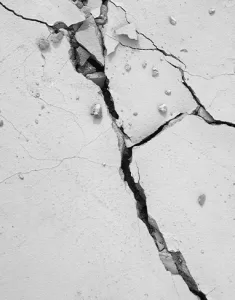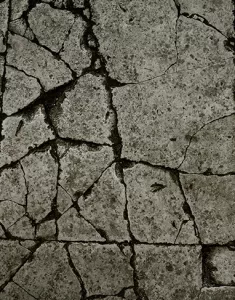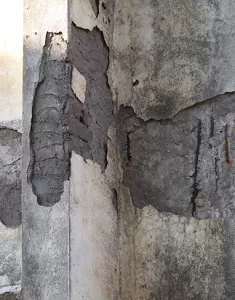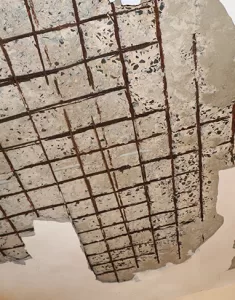
Enquire Now

Concrete Spalling: What is it and How Can You Repair it?
The word ‘spall’ refers to the process of breaking into small sections. This could apply to concrete, rocks, stone or even ore. Spalling of concrete is simply the occurrence of concrete breaking into smaller sections. It includes chipping off the main body and results in the exposure of reinforcement. Concrete spalling affects a wide range of structures, including framed buildings, multi-level parking garages, bridges, jetties, tanks, and bunds.
This occurrence exposes aggregate beneath the concrete surface, making it uneven and pitted. Spalling should be corrected as soon as possible because it undermines the concrete surface integrity and jeopardizes the member’s ultimate capacity. Furthermore, it may distort the structure’s aesthetic look.

What causes concrete spalling?
Various reasons and factors contribute to the spalling of concrete, such as :
- ➔When the products of corrosion such as rust take up more volume than the original steel reinforcement, causing the concrete to spall
- ➔Due to fire exposure, free water in concrete changes to steam and creates internal expanding pressure in the concrete, causing it to spall
- ➔Cycles of freezing and thawing
- ➔Alkali-Silica reaction’s expansive effects
- ➔Insufficient cover depth over reinforcement
- ➔Covering reinforcing steel with low-quality concrete
- ➔Joint spalling is frequently caused by construction joints that are inadequately designed
- ➔Differences in shrinkage between the topping and base courses, drying of the bonding grout before the topping concrete is laid, and a few other factors all contribute to bond failure in two-course construction. This, in turn, leads to the spalling of concrete

How can you prevent concrete spalling?
- ➔Early dry-cutting of the concrete floor helps to prevent spalling.
- ➔To keep water out of the concrete, apply a suitable water sealer to the final surface.
- ➔Proper concrete management while pouring ensures appropriate cover and proper joint placement.
- ➔Excess usage of water in the concrete mixture leads to concrete spalling. Therefore it is best to avoid using extra water.

How can you repair concrete spalling?
- ➔When the spalling damage is less than 1/3 of the concrete’s thickness, a surface repair is typically possible. Steel bars may be necessary if the damage is larger than 1/3 of the depth, and a complete depth repair may be required.
- ➔Due to exposure, corroded rebar must be cleansed at the start of the repair procedure. After the rebar has been properly cleaned with the help of a wire brush and all corrosion has been removed, it should be coated with a rust inhibitor to prevent further corrosion.
- ➔A cementitious overlay can be used to repair damage on driveways, sidewalks, and other horizontal surfaces. To avoid recurrence of spalling, use a waterproofing membrane once the overlay has completely dried.
- ➔Patching might be an alternative for repairing random or localised damage, provided the patches extend to at least four inches beyond the spalled portions. To assist confine and securing the patch, saw-cut the surface in the patch region for optimal results.
- ➔Before applying patching material, make sure the surface is clean of dirt and small particles, and that it is totally dry. The previous concrete surface should be rough to give teeth and better grip for proper adhesion. The ideal patching materials are Portland-cement-based or epoxy-based, and they should be mixed preferably right before use.
- ➔Temperature plays an important role when it comes to repairing spalled concrete. For patching or other restoration operations, the air temperature must be above 40 degrees Fahrenheit to guarantee appropriate bonding and curing of the repair material.
- ➔The expansion coefficient of repair materials should be identical to that of the previous concrete mixture.
- ➔Any seams or joints that are fixed must allow for concrete slab expansion.
Although spalling concrete can be easily treated, it is best to maintain the integrity of the concrete through proper care and maintenance. Coating the concrete surface with water-resistant formulas is an effective way to maintain concrete health.





